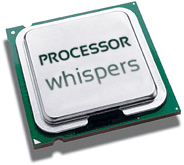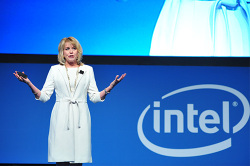Processor Whispers: Of poor figures and good prospects
 by Andreas Stiller
by Andreas Stiller
One week before Intel announced the not so brilliant quarterly figures, the company held its Asian developer forum. We might see 22nm Atoms with a new microarchitecture sooner than expected.
While Intel is still looking for a new boss – there's not much time left before the next share holder meeting on 16 May – the PC market continues its descent and Intel's quarterly figures are taking an unwanted dive. The turnover of $12.6 billion is 7% down on the previous quarter and 2.5% down on the same quarter a year ago. Net profits fell by 25% year on year, to $2 billion. Only the Data Center Group, led by Diane Bryant, is swimming against the current with a 7.5% growth to $2.6 billion, but it only makes up 20% of Intel's total turnover. More than 60% are accounted for by conventional PCs and notebooks.
As for servers, Intel's prospects continue to look good and there is little competition: AMD can't keep up anymore and ARM isn't ready yet. At the IDF developer forum in Beijing, Diane Bryant announced new Xeons for the third and fourth quarter: Ivy Bridge-EP as Xeon E5-2600v2, E5-2400v2 and E5-1600v2 for servers with one or two LGA2011 sockets and Ivy Bridge-EX as Xeon E7-4600v2 and E7-8600v2 for systems with four or eight sockets, the latter two with up to 12 terabytes of RAM.

![]() Diane Bryant at IDF in Beijing: her strong management of Intel's server business makes her a possible CEO candidate.
Diane Bryant at IDF in Beijing: her strong management of Intel's server business makes her a possible CEO candidate.
Source: Intel
Bryant didn't talk about the relevant number of CPU cores, but Intel's "Material Declaration Data Sheet" database had already revealed them. The database listed numerous 6 and 10-core CPUs for the two-socket family EP and up to 15 cores for the 4-socket colleagues of the EX family. By now, all these Xeons have disappeared from the database; and, to make it harder to find secret processors in this treasonous database in the future, the interesting column "Die Code Name" has a been eliminated with malice aforethought. Additionally, developer samples, namely chips whose spec code begins with Q, have been removed as well.
The ranks of single-socket and microservers will also soon be extended by the Haswell microarchitecture with AVX2 for example. In the best-case scenario, the newcomers will process computations that benefit from fused multiply-add (FMA) twice as fast as their AVX predecessors: Each Haswell core has two FMA pipelines. The close relatives of the Core i7-4000 are soon expected to arrive under the name Xeon E3-1200v3, together with the mobile and desktop versions at Computex in June.
A 13 watt version with two cores, the Xeon E3-1285Lv3 with 3.1GHz, was particularly highlighted by Bryant: Thanks to the new GPU, which is compatible to OpenCL 1.2 and the Media SDK now also available for Linux, it's supposed to be able to transcode HD videos faster than its predecessors, which is an important factor for content delivery networks. With this move, Intel wants to keep its server customers from switching to server APUs from AMD: Reportedly, a "Kyoto" chip is headed for the HP Moonshot. And a 13 watt Haswell with four AVX2 units should also be able to bite possible server Jaguars from AMD.
Atoms with eight cores
When even less waste heat is tolerable, the server Atoms come into play. For the second half of the year, Bryant promised the 22nm Avoton with the new Silvermont microarchitecture and up to eight cores, which HP plans to offer for Moonshot. At the same time, an Atom SoC for network technology, called Rangeley, is scheduled to be released, and even before that the storage SoC Atom S12x9 with lots of PCIe lanes is due.
Also the head of Intel's PC Client Group, Kirk Skaugen, praised the new Atom architecture, which he announced as the "Bay Trail" platform for the so-called holiday season, the shopping event that unfolds around Thanksgiving in the USA. Bay Trail essentially consists of the Valleyview SoC with two or four Silvermont cores and the "Gen7" GPU. This allows for faster Windows 8 and Android tablets, but also for cheap touch notebooks with very long battery life – the Atom Z2760 already shines with that.
However, the Atom business only accounts for a small portion of Intel's earnings, namely just a meagre billion, which equates to less than 8%. Besides, with a drop of 8%, the Atom sales shrank even more drastically than the conventional PC sector; which may be the result of the ongoing extinction of the netbook. Therefore, Intel urgently needs to score with tablets and smartphones. The Clovertrail+, alias Atom Z2580, which now makes x86 smartphones with two cores and four threads possible, will contribute to this goal; it was first announced quite a while ago. According to the roadmap, the 22nm Atom generation for smartphones will arrive under the name Merrifield at the start of 2014. Silvermont will then provide out-of-order execution. If it will also feature hyper-threading, is still unknown, and it doesn't seem to support AVX – if you need it, Intel refers you to Haswell.
Its Xeon versions Haswell-EP and Haswell-EX were not mentioned in Beijing, but in Munich instead, if only indirectly. There – or rather, a few kilometres north of there, at the Leibniz Supercomputing Centre in Garching – a contract for an upgrade of the SuperMUC supercomputer has been signed with IBM. The state of Bavaria and the federal government of Germany each provide half of the €34 million (about $44.4 million) that the project is going to cost. Like SuperMUC, the upgrade will use special high-temperature water cooling. It is scheduled to go on line with the new Xeons at the start of 2015.
According to IBM, 74304 cores are designed to double SuperMUC's theoretical peak performance to 6.4 petaflops. Mathematically, that would match 4644 Haswell-EP processors with a clock speed of 2.7GHz and 16 cores each, which indicates that – as assumed in a previous issue of Processor Whispers – the Haswell-EP might indeed have 16 cores, even though, up to now, only the number 14 has been mentioned. The Haswell-EX is believed to arrive with 16 to 20 cores. If SuperMUC's flops relate to Haswell's FMA capabilities, the upgrade in Garching should only require a fourth of the nodes and racks of the current system. Possibly, the new Haswell Xeons will already be able to handle DDR4 memory too.
On the margins of IDF, also a detail about the desktop PC chipsets Z97 and H97, and thus about the series 9, was revealed. They are supposed to be the first to support SATA Express, the successor of SATA 6G. Thanks to direct PCIe communication and the NVM Express protocol, SSDs are supposed to deliver even higher data-transfer rates and more IOPS.
(djwm)




![Kernel Log: Coming in 3.10 (Part 3) [--] Infrastructure](/imgs/43/1/0/4/2/6/7/2/comingin310_4_kicker-4977194bfb0de0d7.png)

![Kernel Log: Coming in 3.10 (Part 3) [--] Infrastructure](/imgs/43/1/0/4/2/3/2/3/comingin310_3_kicker-151cd7b9e9660f05.png)












